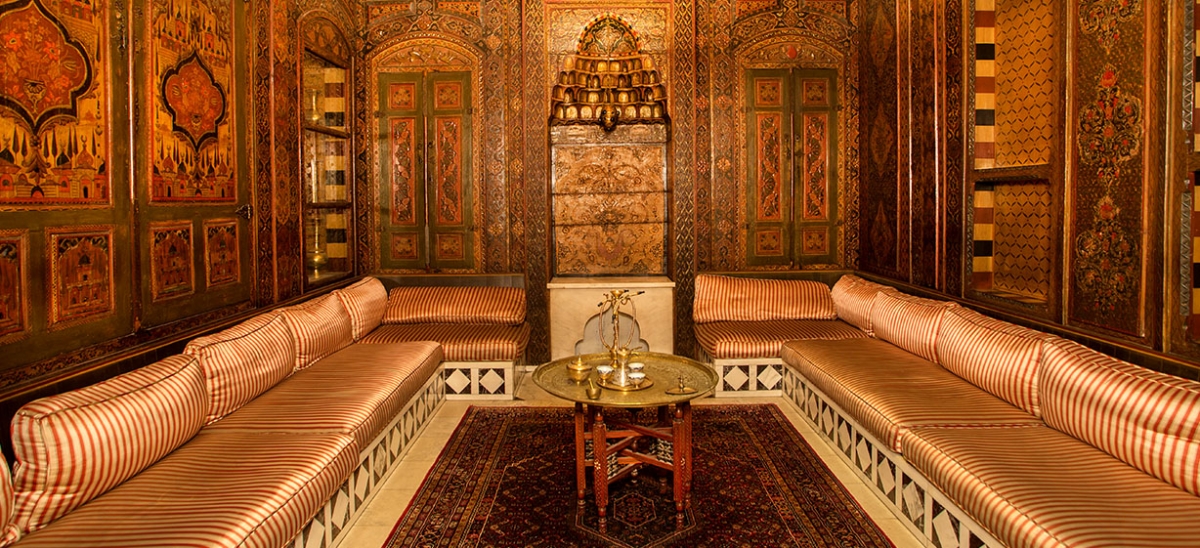A Pittsburgh Masterpiece

When Rachel Rosenberg arrived at the University of Pittsburgh from California as a freshman, she was immediately drawn to the cultural classrooms lining the Cathedral of Learning’s first and third floors: their alluring aesthetics, stunning architecture and meticulous attention to detail.
“There’s nothing like this anywhere else,” she said. “They really set the University of Pittsburgh apart— that we have this representation of different communities and they give the students a fantastic glimpse into these communities as well.”
The 30 spaces comprising Pitt’s Nationality Rooms draw 23,000 paid visitors annually and many more awestruck explorers who wander in regularly. Self-guided tours with handheld informational audio players are $4 for adults and $2 for students. Members of Quo Vadis, a student organization, conduct 90- minute tours by appointment for groups of 10 people or more at $4 a person.
The Nationality Rooms program began in 1926 as the idea of Chancellor John G. Bowman—the man who persuaded Andrew Mellon to fund construction of the Cathedral—and sociologist Ruth Crawford Mitchell, who became their first director. The first set of rooms opened in 1938 and they all portray periods before 1787, the year Pitt was founded.
An example of a few are: the Indian room, inspired by a Buddhist university; the German room, containing walnutand oak-lined walls and ceiling along with splendid stained-glass windows depicting scenes from the Brothers Grimm fairy tales; the Norwegian room with highsloped spruce-paneled ceilings and a corner fireplace. All but two of the 30 rooms function as working classrooms for Pitt students.
“It’s probably the woodwork that I always found most remarkable,” Robert Struble, 51, said as he toured the rooms with his 21-year-old daughter Rachel and her boyfriend. “It’s almost like a museum for art and culture. The craftsmanship is incredible.”
“These rooms are simply living monuments to where Americans came from.” —E. Maxine Bruhns
Rachel Struble, a Grove City College student, was mesmerized by the intricacies. The rooms are decorated in traditional holiday styles in November through mid-January. “This is my first time, and it’s really to cool to see just how unique each room is. You could spend hours here.”
E. Maxine Bruhns, the director of the Nationality Rooms, essentially spent more than half her life inside these threedimensional history lessons. At 92, she is as savvy and dedicated to her job as ever, describing the rooms as her legacy. “These rooms are simply living monuments to where our Americans came from. Everybody came from somewhere. We did not grow on trees. People will come away with a better idea of who they are. You can come here and see what the culture was from various places. It’s deep stuff.”
In 1946, as an Ohio State University student, Bruhns, a West Virginia native, met her future husband, German refugee Fred Bruhns, who came to the United States in 1941 after spending two years in a German prison for resistance to Nazism. The couple lived abroad for 15 years—in Austria, Lebanon, Vietnam, Cambodia, Iran, Germany, Greece and Gabon—with the United Nation’s High Commissioner for Refugees and United States Agency for International Development.
Fred arrived at Pitt in 1965 to complete his Ph.D. and joined the faculty at the Graduate School of Public and International Affairs, where he taught comparative administration and administrative theory. He died in 2006 at age 90. In 1965, with a world of life experiences under her belt, Maxine took over as the Nationality Rooms director. At the time, 19 rooms existed.
“The rooms were finished when I got here and there weren’t plans for any more,” she said. “It was a boring job. I had a closet in Bruce Hall for an office and not much to do.”
She founded an open house event and further developed the tours, which have grown and grown. Now the Quo Vadis tour group boasts 30 guides, who train twice weekly and must master the information of an 80-page packet before giving tours. The club has existed since 1944, making it one of Pitt’s oldest student organizations.
“I love these rooms; they’re so different,” said Pitt freshman Reagan Harper, who became a tour guide in December after training and passing a written test. “My unofficial favorite is the Japanese Room. It’s simple, but there is so much detail to every little thing inside.”
An active scholarship program in conjunction with the rooms’ committees helps raise money for Pitt students to study abroad. Under Bruhns’ direction, the scholarship, known as the Nationality Rooms and Intercultural Exchange Program, continues to expand since its inception in the 1940s.
And Bruhns led the way for 11 additional rooms—from the Israeli Room to the Korean Room, which opened in November on the third floor. She worked with the Korean Heritage committee to raise about $850,000 for its construction. The room represents the “Hall of Enlightenment,” on the campus of Sungkyunkwan University in Seoul, with twin oak columns and a lofted ceiling of wood shipped from Korea. The room also contains a few modern touches for students, including an interactive 85-inch monitor and freestanding desks and chairs designed for laptop use.
Plans are in the works for Iran, Philippines and Finland rooms, Bruhns said, adding that construction can get tricky and political. Each room must be overseen by a committee comprising seven to 30 people, who are responsible for design, fundraising and background of the country.
“It can take years,” she said. “You must have a community in Pittsburgh and convince me that this community can hold on after the room is dedicated. You have to get it planned, raise money and also continue raising money for scholarships for study in that particular country.”
The payoff comes as first-time and frequent visitors marvel over the heritage on display in each room.
“I think it would be really fascinating to take a class in one of these rooms,” said Brendan Biles, a Malvern, Chester County, high school senior during a recent college exploratory visit with his family. “They’re all so unique.”
His 15-year-old sister Macy concurred. “What a beautiful place. You can just get lost in all the history. It’s kind of like touring the world.”
Rosenberg, the student tour guide, loves taking classes in the rooms, including the Hungarian, Scottish and Italian rooms. “It’s definitely a different experience; you are surrounded by history and it’s not always related to what you are learning about. But I think it’s great. What other college students get this opportunity?”
Rosenberg, a linguistics major, joked that tour guides aren’t supposed to have favorite rooms, but her unofficial favorite is the German room. “I’m partially biased because I traveled to Germany this past summer. When I came back, I could see how the room was actually connected to the country. And there’s so much to learn in there because they have representations of cities and fairy tales and all sorts of things of actual geography, culture and history combined.”
She takes a great deal of pride in her touring knowledge. “This place truly is special. We’re giving everyone an important snapshot into various cultures.”




